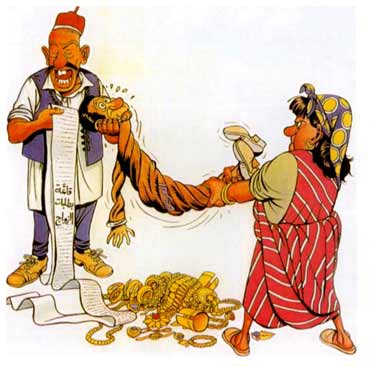Do you want to understand the dowry system in India? Are you interested in understanding the history of dowries and the system in India? Read our guide for more facts and information…
The dowry system has existed historically in India for a variety of reasons. A dowry is traditionally a form of gift given from the bride’s parents to the proposed groom’s family. It was originally intended to protect the bride from poor future circumstances as it would finance her new family in times of unforeseen adversity. The gift is not only the exchange of money but also goods such as furniture, livestock, appliances or even a car. The dowry system today is not as widely accepted in India; however, it is still practiced although now in an indirect way.
Criticism of the Practice
Today with the concern for women’s rights the dowry system is widely criticized in both India and outside of the country. One of the problems that has emerged with the dowry system is that it is traditional in India for a girl to marry a boy with more education. This situation makes it difficult for more educated girls to marry as the more educated a boy the higher the requested amount is. The practice is also criticized as instead of providing for the girl in case of unforeseen circumstances today it is regarded as appeasing the greed of the groom’s family.
The above criticisms are secondary to the primary issue surrounding the dowry system of women’s rights. It is commonly said that the dowry system contributes to the degradation of women and damages the status of women in the countries that accept the practice. It is also suggested that the dowry system practice hurts the bride’s family as they are forced to part with valuable resources to provide for their daughter in the traditional practice. It is also suggested by some that if the amount is deemed insufficient by the groom’s family that the bride can commonly be treated with cruelty.
Dowry Prohibition
In response to the criticism of the dowry system the Indian government acted in 1961 by legislating the Dowry Prohibition Act in 1961. The Dowry Prohibition Act outlawed the practice of the dowry system; however, it is realized in India that the practice still exists. Today, many dowries are accepted directly but more commonly through indirect means. The law can also be circumvented as gifts given without precondition are still considered legal.
The Dowry Prohibition Act does not outline punishments for participating in the dowry system; these punishments include imprisonment or a fine. The fine usually is 5000Rs and the term of imprisonment will not exceed six months. The Dowry Prohibition Act also prompted more awareness of the potential harm to women. In the past instances had been known where the bride had been burnt to death when an insufficient dowry was presented so that the groom could remarry. In light of these situations the government now investigates the death of recent brides particularly if the death is believed to be a suicide. There is no charge or penalty for filing a false case of dowry death. The charge of dowry death can be considered within seven years of the suspected death and the charge is prompted through evidence of suspected mistreatment prior to the death. The charge of dowry death carries a sentence ranging from seven years of imprisonment up to life.





